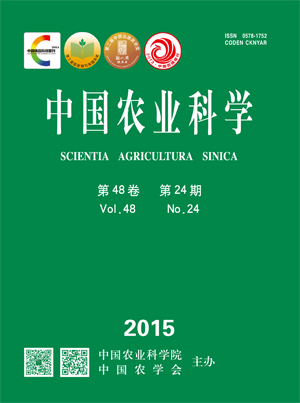-
Effects of Spraying Uniconazole on Lodging Resistance of Culm and Yield in Common Buckwheat
- LIU Xing-bei, WU Dong-qian, WANG Can, HU Dan, YANG Hao, SHE Heng-zhi, RUAN Ren-wu,YUAN Xiao-hui, YI Ze-lin
-
Scientia Agricultura Sinica. 2015, 48(24):
4903-4915.
doi:10.3864/j.issn.0578-1752.2015.24.005
-
 Abstract
(
695 )
Abstract
(
695 )
 HTML
(
2 )
HTML
(
2 )
 PDF (479KB)
(
893
)
PDF (479KB)
(
893
)
 Save
Save
-
References |
Related Articles |
Metrics
【Objective】Common buckwheat (Fagopyrum esculentum M.) has been praised as one of the green foods of human beings in the 21st century. Lodging is an important factor which limiting common buckwheat yield and quality worldwide, so exploring the effects of spraying uniconazole of different concentrations on culm could provide a theoretical basis for lodging resistance cultivation of common buckwheat. 【Method】 The field experiments were conducted as a randomized block design in 2013 and 2014 at the Xiema Experimental Station, Southwest University, China. Ningqiao 1, a moderate lodging resistance cultivar of common buckwheat, was used in this study. 0 mg·L-1 (CK), 25 mg·L-1 (T1), 50 mg·L-1 (T2), 75 mg·L-1 (T3), and 100 mg·L-1 (T4) uniconazole were sprayed at the rate of 100 mL·m-2 on common buckwheat leaf surfaces at the four-leaf stage. The culm snapping resistance, lodging index, culm morphology characteristics, and culm anatomical structure were measured and analyzed at the anthesis stage, filling stage, and maturity stage, respectively. The lodging behavior and yield were investigated at the maturity stage.【Result】The culm snapping resistance, culm wall thickness, and vascular bundle area increased and then decreased from the anthesis stage to maturity stage, and their maximum values appeared in the filling stage. The lodging index, plant height, culm gravity height, culm fresh weight, basal 2nd internode length, basal 2nd internode diameter, mechanical tissue thickness, and vascular bundle number increased from the anthesis stage to the maturity stage. The basal 2nd internode dry weight, filling degree, and mechanical tissue layer number increased from the anthesis stage to the filling stage, but then changes were not obvious. The yield, culm snapping resistance, basal 2nd internode diameter, basal 2nd internode dry weight, filling degree, mechanical tissue layer number, mechanical tissue thickness, culm wall thickness, vascular bundle number, and vascular bundle area increased with the increase of the concentration of uniconazole in the condition of CK-T3 treatments, while decreased with the increase of the concentration of uniconazole in the condition of T3-T4 treatments. The lodging percentage, lodging index, plant height, culm gravity height, culm fresh weight, and basal 2nd internode length decreased with the increase of the concentration of uniconazole in the condition of CK-T3 treatments, while it increased with the increase of the concentration of uniconazole in the condition of T3-T4 treatments. Compared with the control, the yield under the T1, T2, T3 and T4 treatments increased by 2.3%, 6.5%, 21.3%, and 11.3%, respectively, and the lodging percentage decreased by 17.9%, 40.7%, 84.0%, and 60.5%, respectively. There were significant differences in culm snapping resistance, lodging index, culm morphological structure, and culm anatomical structure among different treatments of uniconazole concentration. Plant height, culm gravity height, culm fresh weight, basal 2nd internode length , lodging index, lodging percentage were significant and negatively correlated with the yield. However, the basal 2nd internode diameter, basal 2nd internode dry weight, filling degree, mechanical tissue layer number, mechanical tissue thickness , culm wall thickness, vascular bundle area, vascular bundle number and culm snapping resistance are significantly and positively correlated with the yield. The culm snapping resistance, basal 2nd internode diameter, basal 2nd internode dry weight, filling degree, mechanical tissue layer number, mechanical tissue thickness, culm wall thickness, vascular bundle number, and vascular bundle area showed a trend of T3>T4>T2>T1>CK, while the lodging index, plant height, culm gravity height, culm fresh weight, and basal 2nd internode length showed a trend of CK>T1>T2>T4>T3.【Conclusion】In this research, when uniconazole was sprayed 75 mg·L-1, the culm structure could be optimized effectively, the culm quality improved, the lodging risk decreased and the yield of common buckwheat was enhanced. The result would lay a foundation of lodging resistance cultivation of common buckwheat.









